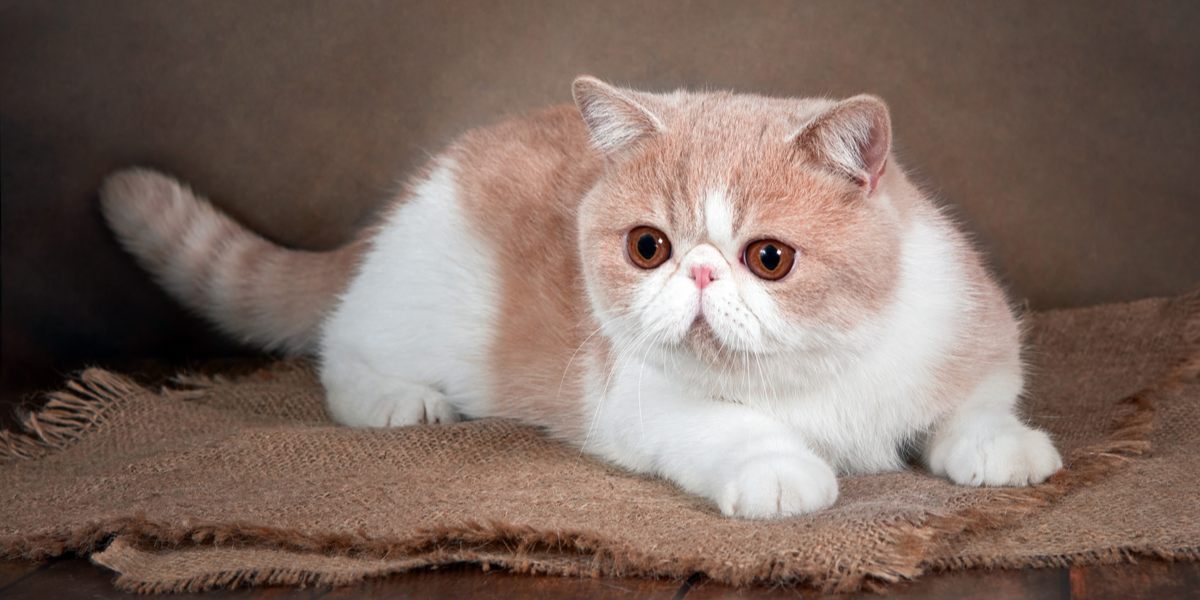
No doubt about it, flat-faced cat breeds are adorable. The short nose, short muzzle, round face, and large eyes give flat-faced felines a very human expression, which cat lovers often find irresistible.
A flat face is a genetically inherited trait seen in a handful of cat breeds (as well as some dog breed, such as the Pug). The scientific term for a flat face is called brachycephalic, which means “shortened head.” Some people say brachycephalic cats have smooshed faces or pushed-in faces.
Among the various brachycephalic cat breeds you will find varying degrees of face “flatness.” Persian cats, Himalayan cats, and Exotic Shorthair cats have some of the most extreme flat faces; this is not surprising since these three breeds are related.
Some other cat breeds are considered brachycephalic, but the flatness is more moderate (though just as cute).
Which Cat Breeds Have Flat Faces?
Flat-faced cat breeds are among the cutest of all cats. Of all the cat breeds, only a handful have flat faces. Get to know seven cat breeds that are known for their adorable, smooshed faces:
#1 British Shorthair
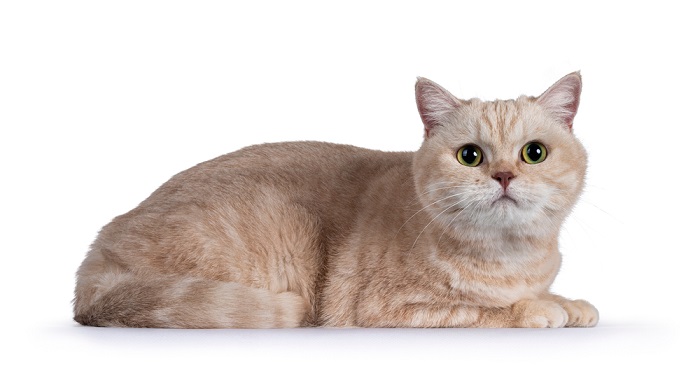
The British Shorthair is a medium to large-sized cat, with a compact, well-balanced body. The short, dense, and very soft coat comes in many colors and patterns, but blue British Shorthairs are especially popular. The British Shorthair’s moderately flat face is very round with round cheeks. The large, round eyes are set well apart, lending to a distinctly human expression.
The British Shorthair’s good looks, combined with its sweet, easy-going, and affectionate personality make this breed an instant charmer. A related breed, the British Longhair, has a similar build, with a moderately flat face, but its coat is longer.
#2 Burmese
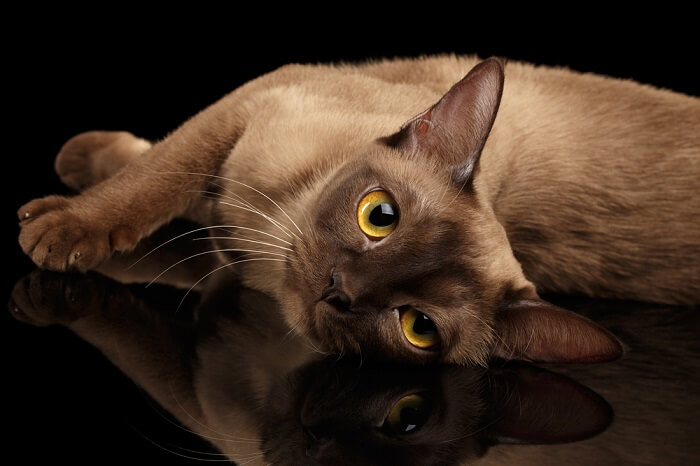
The Burmese is a muscular, compact, medium-sized cat with a very short, glossy, satin-like coat. Its moderately flat face is very round with large, wide, expressive eyes. The Burmese was created in the United States by breeding a walnut-brown cat from Burma with Siamese. Burmese cats are known for being extremely people-oriented and friendly, with dog-like personalities.
The Burmese comes in four colors: sable (rich, warm brown), champagne (warm honey beige), platinum (pale silvery gray with pale fawn undertones), and blue (medium gray with warm fawn undertones).
#3 Exotic Shorthair
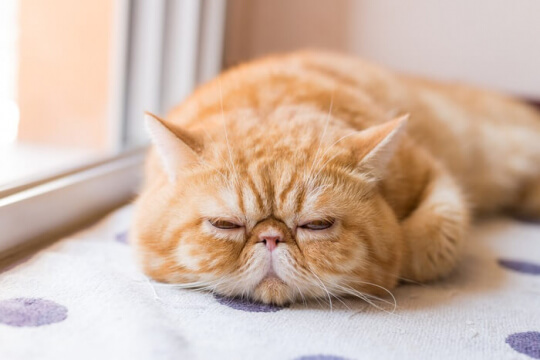
The Exotic, also called the Exotic Shorthair, is essentially a shorthaired Persian, though they are considered separate breeds. Like the Persian, the Exotic has an extreme pushed-in face with a teeny snub nose and large, round, wide-set eyes. The Exotic was created when some breeders began experimenting with outcrossing American Shorthair cats with Persian cats.
The Exotic is meant to look like a Persian in every way except for the coat, which unlike the Persian’s profuse long coat, is short, dense, and plush.
#4 Himalayan
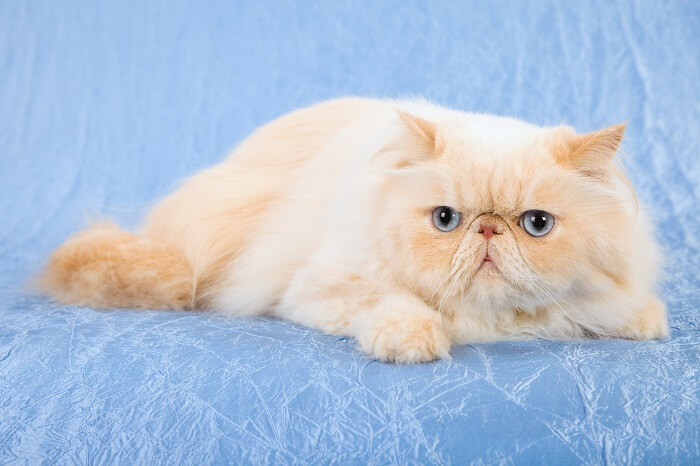
The Himalayan is essentially a color-pointed Persian. It was created by breeding Siamese cats and Persians together, which means Himalayans always have blue eyes and pointed coloration. The International Cat Association (TICA) recognizes the Himalayan as a separate breed from the Persian, but the Cat Fanciers Association (CFA) consider the Himalayan a color division of the Persian cat.
Color-point cats have light-colored bodies with darker “points” of color on the extremities (face, ears, legs, and tail). The Himalayan cat comes in many shades, including chocolate, seal, lilac, blue, and red. Like the Persian cat, Himalayans are loving, laid-back lap cats.
#5 Persian
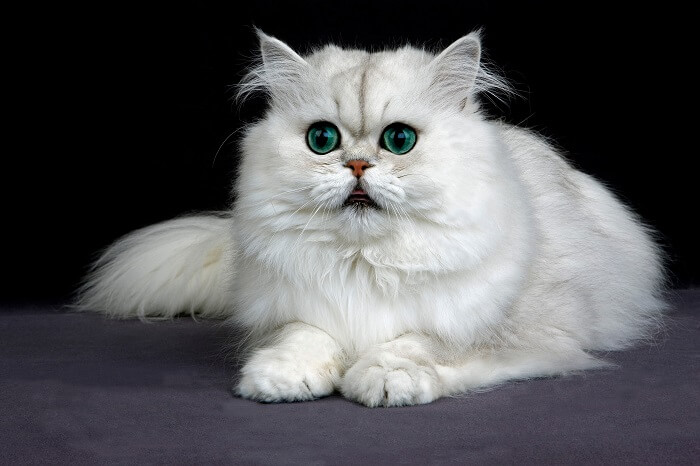
The Persian is probably the most famous of all the cats with flat faces. The Persian has an extremely flat face. In fact, the breed standard states that when viewed in profile, the Persian’s forehead, nose and chin should appear to be in vertical alignment. The Persian’s flat face, combined with its large, round, full eyes set far apart gives the cat a very sweet expression on its face.
The Persian is a very ancient breed that originated in Persia and Iran hundreds of years ago. The Persian is prized for its sweet, loving temperament (it loves to cuddle), and long, flowing coat, which requires significant upkeep to prevent matting.
#6 Scottish Fold
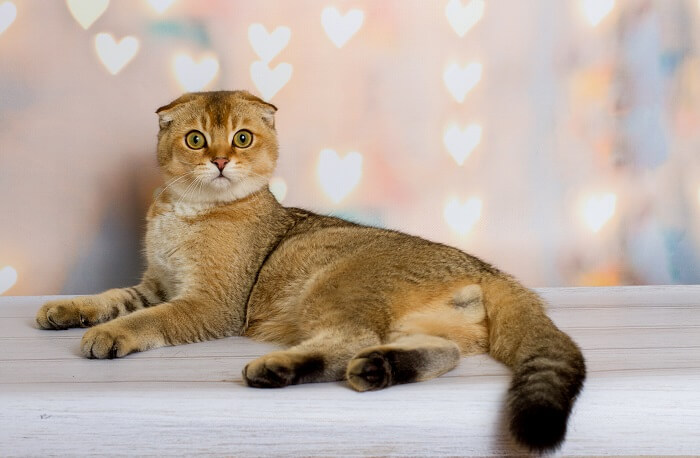
The Scottish Fold’s round head, pushed-in face, large round eyes, and folded ears give this breed the appearance of an adorable owl or teddy bear. The Scottish Fold breed was created after a white kitten from a litter of barn cats in Scotland was born with a genetic mutation that caused her to have folded ears. Someone loved the look of this unique cat, and bred her to carry on the genetic trait.
Scottish Fold kittens are born with straight ears. Some kittens do not have the gene for folded ears so their ears remain straight, but the ears of kittens with the gene begin to fold around 3 to 4 weeks of age. Scottish Folds are sweet and adaptable, making them wonderful companions.
#7 Selkirk Rex
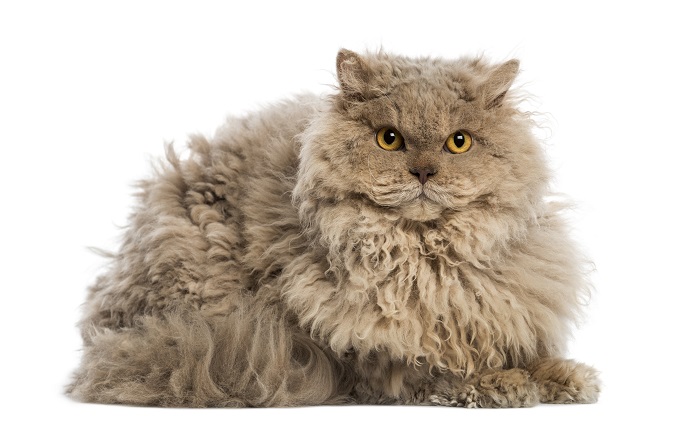
The Selkirk Rex has Persian cat blood in its background, so it’s no surprise it inherited a flat face, although it’s less extreme than that of the Persian. Rare among cat breeds, the Selkirk Rex has a naturally curly coat, which may be long or short. Selkirk Rex even have curly whiskers! This breed is loving, tolerant and very patient.
Health Problems For Flat-faced Cats
Many flat-faced cats live comfortably without any health issues, but the structure of the face, throat, and nose can cause breathing problems in some cats. In particular, brachycephalic breeds are prone to something called brachycephalic airway syndrome (also called congenital obstructive upper airway disease), which refers to a group of related issues commonly seen in flat-faced breeds that can cause difficulty breathing.
In some flat-faced cats, the shape and size of the face, nose, trachea and soft palate can be formed in such a way that they obstruct or reduce air flow. Some flat-faced breeds of cat may be born with one or more the following disorders:
- Elongated soft palate (the soft part of the roof of the mouth), which can block air going into the lungs
- Narrow trachea (windpipe)
- Stenotic nares (very narrow, small nostrils which make breathing through the nose difficult
- Everted laryngeal saccules (tissue in front of the vocal cords is pulled into the windpipe, blocking airflow to the lungs)
Signs that a flat-faced cat may be struggling with one or more of the above conditions include noisy breathing (snorting, snuffling or snoring), gagging or vomiting, exercise intolerance, heat intolerance, cyanosis (gums or tongue turning blue), or sudden collapse, especially after exercise or exertion.
If you think your flat-faced cat is struggling to breath properly, visit your veterinarian for a diagnosis and treatment. If your cat is overweight or obese, a vet-supervised weight-loss program can make it easier for your cat to breath. Sometimes, surgery can correct the physical problems obstructing air flow.
Frequently Asked Questions
What are the cats with flat faces called?
Cats with flat faces are called brachycephalic, which means “shortened head.” Brachycephalic cats have distinctive facial features, including pushed-in faces with short noses and shortened muzzles. Some people refer to these breeds as smoosh faced or cats with pushed-in faces.
What cats have the squashed face?
A few cat breeds have flat faces, including the British Shorthair, Burmese, Exotic, Himalayan, Persian, Scottish Fold, and Selkirk Rex. Among these breeds, the Persian, Himalayan, and Exotic have the most extreme flat faces. The British Shorthair, Burmese, Scottish Fold, and Selkirk Rex have moderately pushed-in faces.
Do flat faced cats suffer?
Although many flat-faced cats (known as brachycephalic cats) live comfortably without any issues, the shape of the face, throat, and nose can cause problems in some flat-faced cats. Some of the health issues associated with flat faces include an elongated soft palate, narrow trachea, stenotic nares, and everted laryngeal saccules.
Signs that a flat-faced cat may be experiencing breathing-related health problems include noisy breathing, gagging, difficulty exercising, trouble tolerating warm temperatures, and cyanosis (gums or tongue turning blue).



